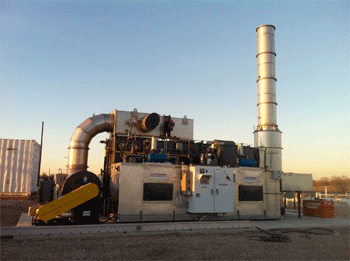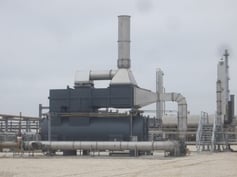Thermal Oxidizer Options for Tail Gas Emissions Control
Depending on the concentration of methane, as well as other VOC constituents there are several types of thermal oxidizers which are considered for controlling these "tail gas" emissions:
Regenerative Thermal Oxidizer (RTO)
The most efficient thermal oxidizer for low CH4 concentration tail gas control, is a Regenerative Thermal Oxidizer (RTO). During operation of the standard two chamber RTO, the VOCs are directed into one of the system’s regenerators, an internally insulated vessel containing specialized ceramic media heat exchanger which allows thermal rate efficiencies up to 97%.

The contaminated gases are passed through the first regenerator where energy is transferred from the ceramic media to the gas in order to elevate the temperature. This elevated temperature approaches the ignition level for most solvents and is then directed from the ceramic bed into the combustion chamber. As the stream exits the ceramic bed and travels through the internally lined combustion chamber, minimal heat is added to ensure a proper oxidation temperature and a designed dwell time is maintained providing destruction of the VOCS at greater than 98% efficiency. The resultant clean, oxidized gases are directed to the second regenerator to absorb the heat energy before being released to the atmosphere.
table of contents
Direct Fired Thermal Oxidizer (DFTO)
 A Direct Fired Thermal Oxidizer is used on applications that have very high solvent concentration levels, low air volumes, or particulate present. While offering the lowest capital expense investment, this is usually offset by high supplemental fuel usage required to operate.
A Direct Fired Thermal Oxidizer is used on applications that have very high solvent concentration levels, low air volumes, or particulate present. While offering the lowest capital expense investment, this is usually offset by high supplemental fuel usage required to operate.
table of contents
Recuperative Thermal Oxidizer
 A Recuperative Thermal Oxidizer integrates a heat exchanger into the design in order to minimize the fuel used for oxidation. By passing the hot exhaust gasses through a stainless-steel, non contact air-to-air primary heat exchanger, recovered heat is used to warm the incoming air to the oxidizer. These systems are more fuel efficient than a DFTO, however they are still less efficient than an RTO.
A Recuperative Thermal Oxidizer integrates a heat exchanger into the design in order to minimize the fuel used for oxidation. By passing the hot exhaust gasses through a stainless-steel, non contact air-to-air primary heat exchanger, recovered heat is used to warm the incoming air to the oxidizer. These systems are more fuel efficient than a DFTO, however they are still less efficient than an RTO.
table of contents
Thermal Combustor System
 A Thermal Combustor System (TCS) combines the simplicity of an enclosed flare with the robustness and proven performance of a thermal oxidizer. The TCS are widely flexible and can confidently handle the vent gas that may or may not be within the flammable range. The TCS provides an extraordinary level of safety when compared to traditional flaring systems.
A Thermal Combustor System (TCS) combines the simplicity of an enclosed flare with the robustness and proven performance of a thermal oxidizer. The TCS are widely flexible and can confidently handle the vent gas that may or may not be within the flammable range. The TCS provides an extraordinary level of safety when compared to traditional flaring systems.
table of contents
What is Renewable Natural Gas (RNG)?
Renewable natural gas (RNG) is a term used to describe anaerobically-generated biogas that has been upgraded (or refined) for use in place of fossil natural gas. Raw biogas typically has a methane (CH4) content between 45 and 65 percent, depending on the source of the biogas, and must go through a series of steps to be converted into RNG. Biogas is treated to remove moisture, carbon dioxide (CO2) and trace-level contaminants (including siloxanes, volatile organic compounds (VOCs) and hydrogen sulfide (H2S), as well as reducing the nitrogen (N2) and oxygen (O2) content. Once purified, the RNG has a CH4 content of 90 percent or greater. RNG injected into a natural gas pipeline commonly has a CH4 content between 96 and 98 percent.
Main Sources of RNG
There are four main sources of biogas used to produce RNG in the United States. At each of these types of operations, biogas is produced as the organic materials are broken down by microorganisms in the absence of O2 (i.e., anaerobic conditions). “Organic” in this context means the wastes come from, or were made of, plants or animals.
- Municipal solid waste (MSW) landfill Gas (LFG)
Landfill gas collection and control systems capture methane gas generated in MSW landfills as the organic wastes decompose anaerobically. Instead of escaping into the air, LFG can be captured, converted and used as an energy resource. Applicable federal and state regulations require certain landfills to capture and destroy the LFG generated.
The US EPA Landfill Methane Outreach Program (LMOP) is a voluntary program that works cooperatively with industry stakeholders and waste officials to reduce or avoid methane emissions from landfills. LMOP encourages the recovery and beneficial use of biogas generated from organic municipal solid waste.
In 2024 the United States Environmental Protection Agency (EPA) has issued an enforcement alert intended to remind municipal solid waste (MSW) landfill operators and owners, and their consultants, of their obligation to properly design, install, operate, and maintain gas collection and control systems (GCCS). Waste or tail gas is sent to a flare or thermal oxidizer for control.
- Municipal Water Resource Recovery Facilities (WRRFs) - Anaerobic digestion (AD)
Many municipal WRRFs (also known as wastewater treatment facilities or publicly owned treatment works) use AD to treat sewage sludge on site, while some facilities send the sludge to other facilities for AD treatment. Biogas is one of the byproducts of sludge treatment through AD. WRRFs typically generate biogas with a high CH4 content and extremely low N2 and O2 contents, which make them attractive candidates for RNG projects.
- Livestock Farms - Anaerobic digestion (AD)
Livestock farms can use AD to convert livestock (e.g., dairy, beef, swine, poultry) manure into biogas and digestate (the nutrient-rich material left over after AD). Some manure-based digesters co-digest other waste materials with the manure, including upstream (pre-consumer) food wastes such as beverage and distillery waste; fats, oils and greases; industrial food byproducts; or processing wastes from a dairy or slaughterhouse.
Renewable Natural Gas (RNG) from Agricultural-Based AD/Biogas Systems is a focus of several Federal and State public policy initiatives. More information can be found from the US EPA
AgSTAR program, which is a collaborative program sponsored by the EPA and USDA that promotes the use of biogas recovery systems to reduce methane emissions from livestock waste.
- Organic waste management operations - Anaerobic digestion (AD)
Stand-alone digesters are the newest source of RNG in the United States. These AD projects break down source separated organic material including food waste to generate biogas, which can be converted to RNG. Digesters that primarily process food waste can also co-digest other organic materials including yard waste.
The Future of RNG
As a substitute for fossil natural gas, RNG has many potential uses. RNG can be used as vehicle fuel, to generate electricity, in thermal applications, or as a bio-product feedstock. RNG can be injected into natural gas transmission or distribution pipelines, or it can be used locally (i.e., at or near the site where the gas is created).
Developing RNG resources is one way to diversify fuel supplies and increase fuel security, provide economic benefits to communities and end users, improve local air quality and reduce greenhouse gas (GHG) emissions.
The US EPA’s An Overview of Renewable Natural Gas from Biogas provides resource to promote and potentially assist in the development of RNG projects and provides technical information on how raw biogas is upgraded into RNG.




 A
A  A
A  A
A 




